Advertisements
Advertisements
प्रश्न
The base BC of triangle ABC is produced both ways and the measure of exterior angles formed are 94° and 126°. Then, ∠BAC =
विकल्प
94°
54°
40°
44°
उत्तर
the given problem, the exterior angles obtained on producing the base of a triangle both ways are 94°and 126°. So, let us draw ΔABC and extend the base BC, such that:
∠ACD = 126°
∠ABE = 94°
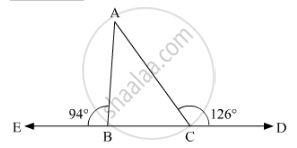
Here, we need to find ∠BAC
Now, since BCD is a straight line, using the property, “angles forming a linear pair are supplementary”, we get
∠ AC+ ∠ ACD = 180°
∠ ACB + 126° = 180°
∠ ACB = 180° - 126°
∠ ACB = 54°
Similarly, EBS is a straight line, so we get,
∠ ABC + ∠ ABE = 180°
∠ ABC + 94° = 180°
∠ ABC = 180° - 94°
∠ ABC = 86°
Further, using angle sum property in ΔABC
∠ ABC + ∠ ACB + ∠ BAC = 180°
54° + 86° + ∠ BAC = 180°
∠ BAC = 180° - 140°
∠ BAC = 40°
Thus, ∠ BAC = 40°
APPEARS IN
संबंधित प्रश्न
ABC is an isosceles triangle in which altitudes BE and CF are drawn to equal sides AC and AB respectively (see the given figure). Show that these altitudes are equal.
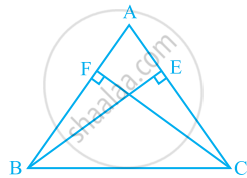
ABC and DBC are two isosceles triangles on the same base BC (see the given figure). Show that ∠ABD = ∠ACD.
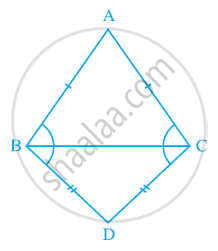
In figure, AB = AC and DB = DC, find the ratio ∠ABD : ∠ACD
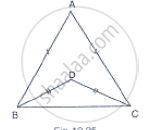
In Fig. 10.23, PQRS is a square and SRT is an equilateral triangle. Prove that
(i) PT = QT (ii) ∠TQR = 15°
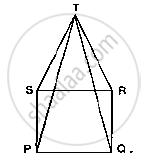
The vertical angle of an isosceles triangle is 100°. Find its base angles.
Which of the following statements are true (T) and which are false (F):
If the bisector of the vertical angle of a triangle bisects the base, then the triangle may be isosceles.
Fill the blank in the following so that the following statement is true.
In an isosceles triangle ABC with AB = AC, if BD and CE are its altitudes, then BD is …… CE.
If ∆PQR ≅ ∆EDF, then is it true to say that PR = EF? Give reason for your answer
ABC is an isosceles triangle with AB = AC and D is a point on BC such that AD ⊥ BC (Figure). To prove that ∠BAD = ∠CAD, a student proceeded as follows:
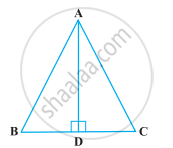
In ∆ABD and ∆ACD,
AB = AC (Given)
∠B = ∠C (Because AB = AC)
and ∠ADB = ∠ADC
Therefore, ∆ABD ≅ ∆ACD (AAS)
So, ∠BAD = ∠CAD (CPCT)
What is the defect in the above arguments?
[Hint: Recall how ∠B = ∠C is proved when AB = AC].
Show that in a quadrilateral ABCD, AB + BC + CD + DA > AC + BD
